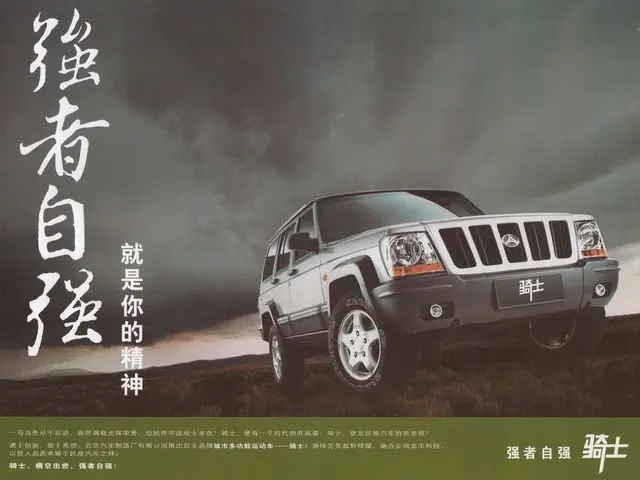Decade of Robo-Taxis Declared by Nvidia CEO Huang - Exploring the Potential Winners
The autonomous vehicle revolution is upon us: "This will be the decade of self-driving cars, robotics, and autonomous machines," declared Nvidia CEO Jensen Huang during a speech at VivaTech in Paris on Thursday. It's no shock – Nvidia is a key player in the autonomous driving tech industry, offering vital hardware and software solutions.
Robotaxis have already made an appearance on US roads. Waymo, Google's subsidiary in autonomous driving, operates robotaxi fleets in various American cities like San Francisco, Phoenix, and Los Angeles. Baidu, China's tech giant, and Pony.ai are similarly testing their self-driving vehicles on Chinese roads. The European market is slowly catching up, with the UK expecting to welcome self-driving cars as early as 2026, thanks to the Autonomous Vehicles Act.
Pioneers in Autonomous Driving
Some big winners in this shift are Uber and Tesla. Uber is partnering with British AI tech company Wayve to test driverless rides in the UK as early as spring 2026. Tesla is introducing its robotaxi service in Austin today, a move that could transform its business model.
Another beneficiary is Pony.ai, a Chinese startup specializing in autonomous driving technology. The company aims to grow rapidly through international expansion, leveraging AI and striving for significant growth. Waymo, with its technological lead and substantial data power, is poised for rapid expansion of its robotaxi service.
Other companies actively participating in autonomous vehicle technology are Nvidia, Tesla, Uber, Pony.ai, and Alphabet's parent company Google. A detailed exploration of robotics and AI trends can be found in DER AKTIONÄR issue 25/2025, available for download here.
Conflict of Interest Disclosure The publisher Börsenmedien AG's board and majority shareholder, Bernd Föst, may have positions, directly or indirectly, in the financial instruments mentioned or related derivatives, which may stand to benefit from the price movements resulting from this publication: Nvidia, Tesla.
The autonomous driving sector is experiencing rapid technological progress, regulatory change, and market expansion, as powerhouses like Waymo, Tesla, Uber, Pony.ai, and Nvidia race to lead the field.
Key Milestones in Autonomous Driving
Regulatory and Policy Evolutions
- Lighter Regulations in the U.S.: The U.S. Department of Transportation (DOT) and National Highway Traffic Safety Administration (NHTSA) loosened regulations, allowing autonomous vehicles (AVs) to operate without traditional human controls like steering wheels and pedals[1][2]. This streamlined review process, reducing approval timelines from years to months, encourages growth for major manufacturers such as Tesla and Waymo[1][2].
Technological Advancements and Research
- Nvidia’s AI & Simulation Chops: Nvidia emerged as a front-runner in autonomous driving research, securing the End-to-End Autonomous Driving Grand Challenge at CVPR 2025 for the second consecutive year. Their Generalized Trajectory Scoring (GTRS) method employs advanced trajectory generation, offering safer and more robust driving paths in a variety of scenarios[4]. Nvidia's platforms enable real-time, scalable simulation, essential for training and validating autonomous systems[4].
- Cloud-Based Simulation and Modular Platforms: By 2034, the global market for autonomous vehicle development platforms is projected to grow to $399.1 billion, spurred by advancements in cloud-based simulations, sensor data fusion, and modular architectures that support varying levels of autonomy[3]. This growth is underpinned by partnerships among automakers, tech suppliers, and software companies, accelerating AV development and testing[3].
Progress by Company
- Waymo: Continues to expand its autonomous ride-hailing services, prioritizing safety and scalability in urban environments.
- Tesla: Benefits from new regulations, striving to incorporate more advanced autonomous features and leverage its vast fleet for data-driven improvements.
- Uber: Although its ambition for fully autonomous vehicles was tempered due to past safety concerns, Uber remains invested in AV research and collaborations, focusing on last-mile solutions and logistics[3].
- Pony.ai: Expanding its autonomous driving platforms and fleet testing in Asia, with a focus on robobus and robotaxi applications[3].
- Nvidia: Beyond hardware, Nvidia leads in end-to-end autonomous driving software, simulation, and research[4].
Prognosis
The industry moves swiftly towards a driverless future, supported by regulatory clarity, advanced simulation tools, and collaborative innovation among tech companies and automakers. The next decade will witness significant growth in autonomous vehicle platforms, with safety and scalability as top priorities[1][2][3].
| Company | Recent Developments & Focus Areas ||-----------|---------------------------------------------------------|| Waymo | Expanding ride-hailing, leveraging new U.S. regulations || Tesla | Advanced autonomy features, regulatory gains, OTA updates|| Uber | AV research, partnerships, last-mile solutions || Pony.ai | Robobus/robotaxi, expanding in Asia || Nvidia | AI, simulation, research wins, hardware/software suites |
- In the race for leadership in the autonomous driving sector, Nvidia, as a key player in the technology industry, leverages its AI and simulation capabilities to drive advancements.
- The European market is poised to see significant growth in autonomous driving, with companies like Waymo, Uber, and Tesla investing in research and expansion.
- The global market for autonomous vehicle development platforms is projected to grow substantially by 2034, fueled by advancements in cloud-based simulations, sensor data fusion, and modular architectures.




